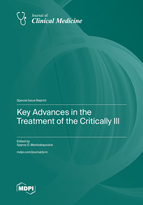Key Advances in the Treatment of the Critically Ill
A special issue of Journal of Clinical Medicine (ISSN 2077-0383). This special issue belongs to the section "Intensive Care".
Deadline for manuscript submissions: closed (16 July 2023) | Viewed by 38339
Special Issue Editor
Interests: cardiac arrest; postcardiac arrest syndrome; mechanical ventilation; ethics of end-of-life decisions; hospital-acquired infections; airway management
Special Issues, Collections and Topics in MDPI journals
Special Issue Information
Dear Colleagues,
It is my pleasure to invite you and members of your research group to submit an article for a Special Issue entitled “Key Advances in the Treatment of the Critically Ill”.
Intensive Care Medicine (ICM) aims to address organ-system failures in the context of an extremely broad variety of acute and severe disease states and coexisting comorbid conditions. Accordingly, survival without severe disability may vary from <10% to >90%. Despite intense randomized controlled clinical research for several decades, only a handful of key interventions have been shown to improve patient outcomes. Examples include lung-protective mechanical ventilation and prone positioning in acute respiratory failure, targeted temperature management, amiodarone, and the vasopressin-steroids-epinephrine combination in cardiac arrest, tranexamic acid in trauma (including head injury), and early antibiotics in sepsis/septic shock. The severe acute respiratory syndrome coronavirus-2 pandemic has prompted urgent and intensified research on the development of effective treatments such as the messenger RNA-based vaccines, the monoclonal antibodies, certain immunomodulating interventions, and the recently authorized coronavirus disease-19 pills. Lastly, extracorporeal membrane oxygenation still constitutes a potentially promising intervention for selected patients with treatment-refractory respiratory and/or circulatory failure. Notably, the rapid evolution of evidence-based ethics of end-of-life decisions seems to increasingly augment the consistency between therapeutic interventions and patient/family values, goals and preferences. We do encourage submissions of reviews and original articles related to any of the aforementioned hot topics of ICM.
Prof. Dr. Spyros D. Mentzelopoulos
Guest Editor
Manuscript Submission Information
Manuscripts should be submitted online at www.mdpi.com by registering and logging in to this website. Once you are registered, click here to go to the submission form. Manuscripts can be submitted until the deadline. All submissions that pass pre-check are peer-reviewed. Accepted papers will be published continuously in the journal (as soon as accepted) and will be listed together on the special issue website. Research articles, review articles as well as short communications are invited. For planned papers, a title and short abstract (about 100 words) can be sent to the Editorial Office for announcement on this website.
Submitted manuscripts should not have been published previously, nor be under consideration for publication elsewhere (except conference proceedings papers). All manuscripts are thoroughly refereed through a single-blind peer-review process. A guide for authors and other relevant information for submission of manuscripts is available on the Instructions for Authors page. Journal of Clinical Medicine is an international peer-reviewed open access semimonthly journal published by MDPI.
Please visit the Instructions for Authors page before submitting a manuscript. The Article Processing Charge (APC) for publication in this open access journal is 2600 CHF (Swiss Francs). Submitted papers should be well formatted and use good English. Authors may use MDPI's English editing service prior to publication or during author revisions.
Keywords
- respiration, artificial
- prone position
- respiratory distress syndrome
- respiratory insufficiency
- heart arrest
- hypothermia, induced
- amiodarone
- vasopressins
- steroids
- epinephrine
- multiple trauma
- wounds and injuries
- tranexamic acid
- sepsis
- anti-bacterial agents
- COVID-19
- COVID-19 Vaccines
- COVID-19 breakthrough infections
- COVID-19 drug treatment
- extracorporeal membrane oxygenation
- ethics
- death
- decision making, shared







